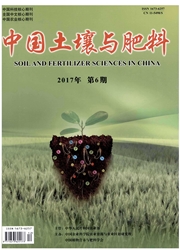

 中文摘要:
中文摘要:
为了探讨棉秆不同处理方式对黄河三角洲滨海盐碱土改良效果的影响,本试验对比棉秆直接粉碎还田(FC)和堆腐还田(FS)两种处理,分别设定不同还田量进行试验,并根据棉花不同生长时期对棉田土壤物理、化学指标进行对比分析。结果表明:FS、FC两种还田处理均能有效增加0~10 cm土层土壤孔隙度,降低土壤容重,且与还田量分别呈正相关和负相关;当还田量为9 t/hm^2时能有效增大土层粒度中黏粒和粉粒所占比重。FS比FC对棉花吐絮期表层(0~10 cm)p H值的降低效果更明显。两种还田处理的降盐效果显著,并随着还田量增大而不断加强。两种还田处理可以有效降低0~20 cm土层土壤中Na^+和Cl^-含量,而当还田量为9 t/hm^2时对降低0~10 cm土层中SO4~(2-)含量及增加K^+、Ca^2+、Mg^2+含量的效果最为明显。两种还田模式均能显著增加土壤有机质含量,但差异性不大,FS较FC在增加全氮和速效钾含量方面效果显著,而在增加有效磷含量方面表现刚好相反。两种还田处理都可以有效增加棉花产量,且FS比FC的增产效果更好。棉秆还田利用不仅可以改善土壤的理化性质,也可以减少资源的浪费。
 英文摘要:
英文摘要:
In order to investigate the effect of cotton straw returning after,different amount of field trials,and cotton field soil physics,chemistry indicators were analyzed according to the different cotton growth periods. The results showed that both kinds of processing 0 ~ 10 cm soil layer increaseand reducet the same time the were respectively presented positively and negative correlation with the amount of returned straw. When the amount of farmland 9 t / hm^2,the proportion of clay and silt increased.p H of topsoil( 0 ~ 10 cm) in cotton boll opening period. treatment were significantly reduc,and with increasing the quantity of returning. Returning process effectively reduce the in the soil. The effects of reducing SO4^- 2 content and increasing the content of K^+,Ca^2 +and Mg^2 +in 0 ~ 10 cm soil layer were the most obvious when the amount of 9 t / hm^2. treaments significantly increase soil organic matter content. increasing soil total nitrogen and available potassium content,,but the effect on available phosphorus opposite. The two treaments effectively increase cotton production,and the FS better than th FC. Cotton straw returning not only improve soil physical and chemical properties but also reduce the waste of resources.
 同期刊论文项目
同期刊论文项目
 同项目期刊论文
同项目期刊论文
 期刊信息
期刊信息
